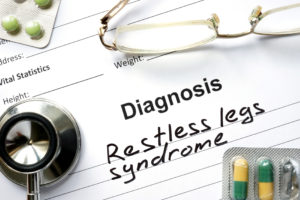Restless Legs Syndrome (RLS) is a neurological disorder that’s characterized by tingling, pulling, throbbing, or other uncomfortable sensations in the legs. People afflicted with RLS tend to notice the symptoms when they’re relaxing. As a response, they move their legs to alleviate the discomfort. That constant motion prevents them from getting a good night’s sleep, which is why RLS is also categorized as a sleep disorder.
RLS Symptoms
People who are afflicted with RLS feel annoying sensations in their legs. Typically, these “pins and needles” or “itchy” sensations flare up when the person is either lying down or sitting.
Patients who have been diagnosed with RLS find that moving their legs will relieve the sensations, but only temporarily. The discomfort will occur again and once again the patient will move about in an effort to alleviate the sensation.
As a Sleep Disorder
RLS is described as a sleep disorder precisely because it strikes people when they’re resting. The awkward sensations occur while the person is trying to sleep. That discomfort causes the patient to move his or her legs to get rid of the feeling. That movement provides temporary relief, until a recurrence of the sensation. The end result is that the person tosses and turns in bed for hours instead of getting proper sleep.
Also, RLS symptoms tend to flare up during the evening – when most people are trying to sleep. This just makes matters worse for patients who are afflicted with RLS and want to get a good night’s sleep.
The Results
People who are afflicted with RLS and don’t get the proper sleep exhibit the same problems as anyone else who is sleep-deprived. Often times, the patient will become increasingly irritable. That irritability could put a strain on both personal and professional relationships.
In addition to those side effects, a lack of proper sleep also carries significant health risks. People who don’t get proper rest are more susceptible to heart disease and a stroke.
What Causes RLS?
For the most part, doctors simply don’t know what causes RLS. They suspect that it is, to some degree, genetic. That’s because nearly half of people with RLS have a family member who is also afflicted with the condition.
Other conditions that may be related to RLS or worsen the symptoms include:
• Chronic diseases – Parkinson’s disease, peripheral neuropathy, kidney failure, iron deficiency, and diabetes are often accompanied by RLS.
• Medications – Antinausea, antipsychotic, allergy, cold, and antidepressant medications that contain antihistamines may worsen RLS symptoms.
• Pregnancy – Some pregnant women experience RLS, especially as they get closer to delivery.
Treatment
Sometimes, RLS is treated by treating the associated medical condition, if one exists. If the patient has either peripheral neuropathy or diabetes, then treatment for RLS starts by treating those conditions.
Sometimes, a doctor will advise the patient to make a lifestyle change. This can include decreasing caffeine, alcohol, and/or tobacco consumption; taking mineral supplements to make up for the deficiency in magnesium, iron, or folate; changing sleep habits; increased exercise; massaging the legs; or taking a hot bath.
There is no medication that properly treats RLS for all patients. Sometimes a doctor will prescribe a medication, such as a dopaminergic agent or an opioid, for treatment. However, in some cases, the medication loses its effect over time, making it necessary for the physician to prescribe a different medication.
The Prognosis
As of this writing, there is no cure for RLS. However, there are treatment options to alleviate the symptoms. These options have resulted in improved sleep patterns for people afflicted with the disorder.


